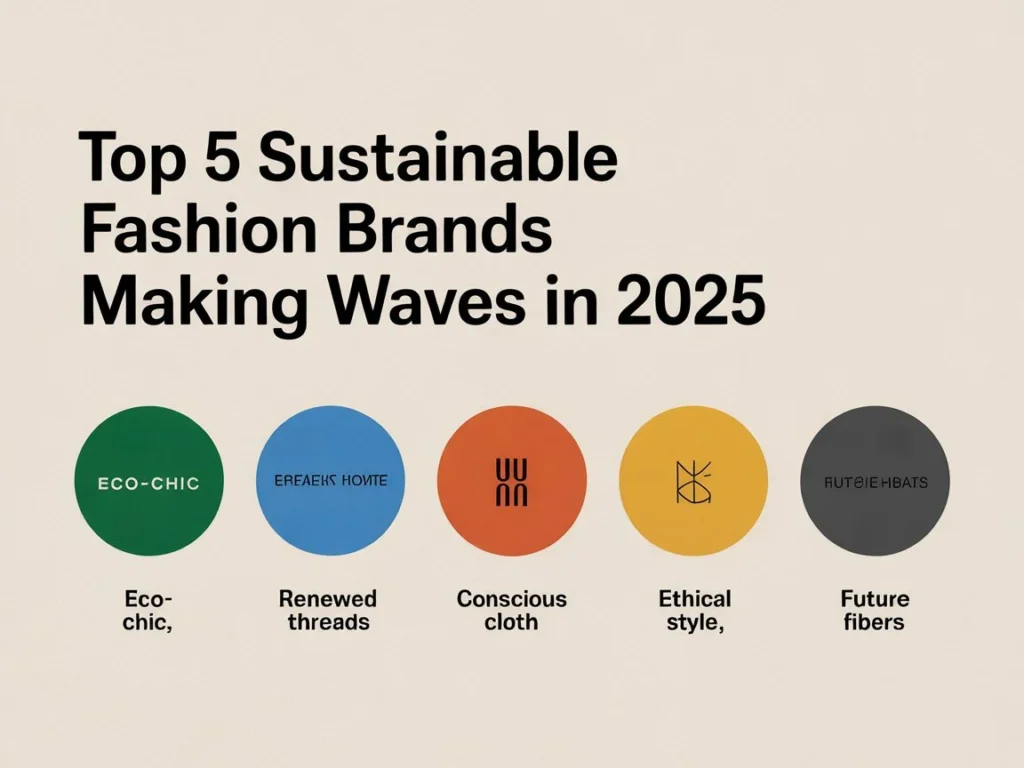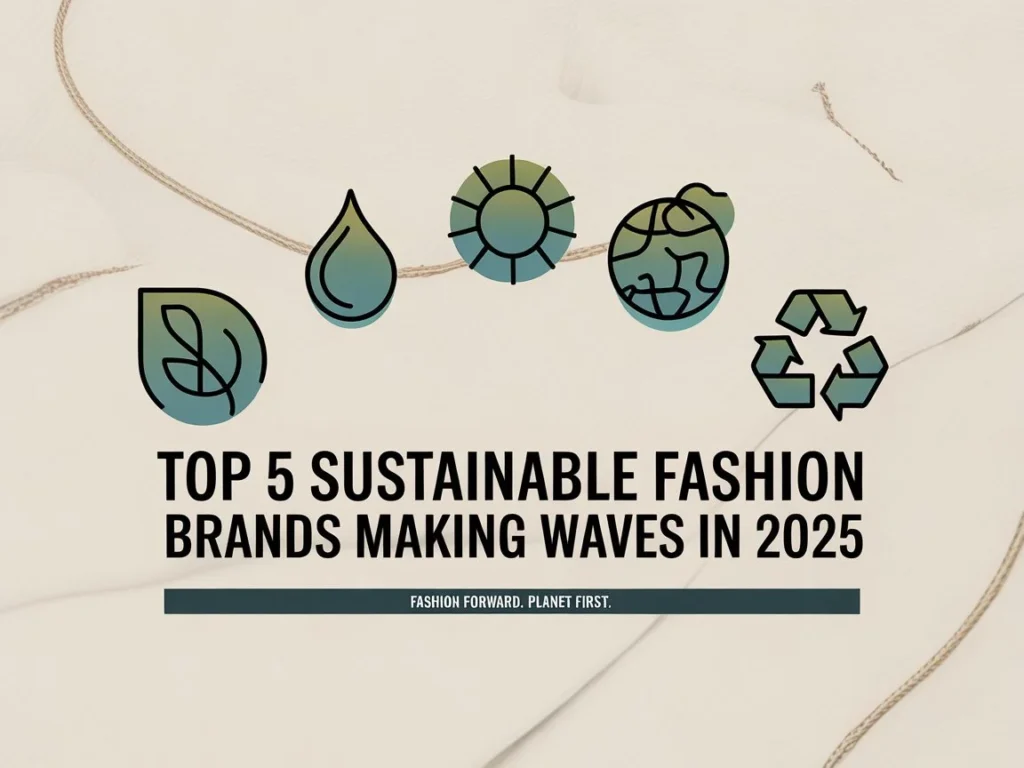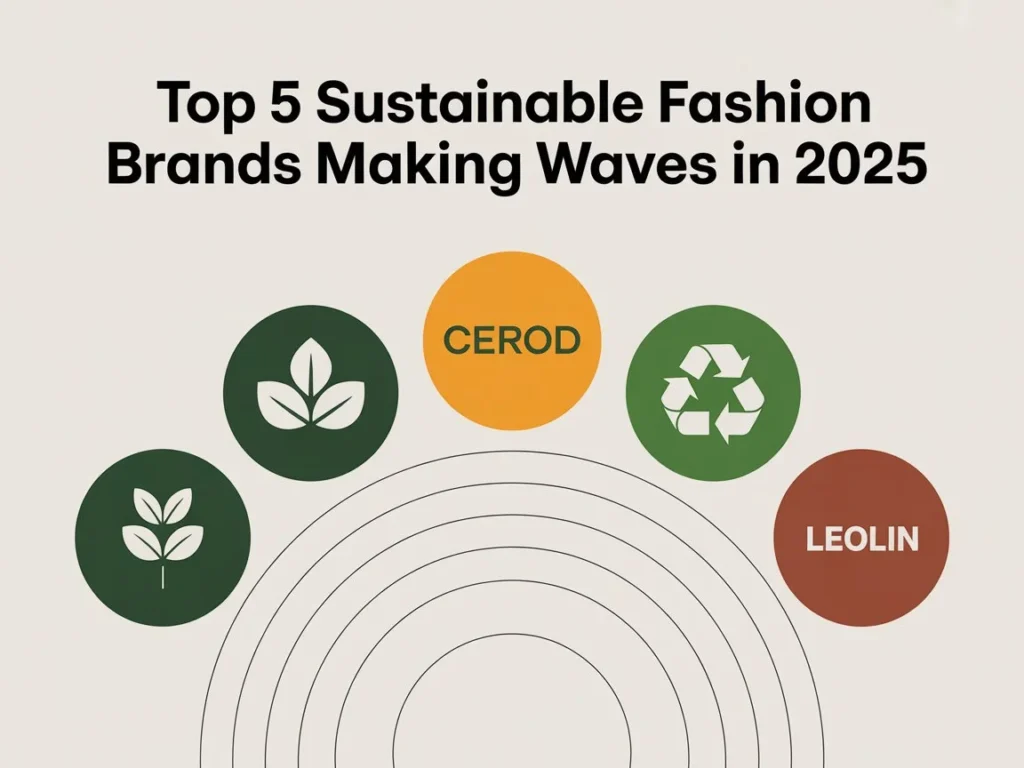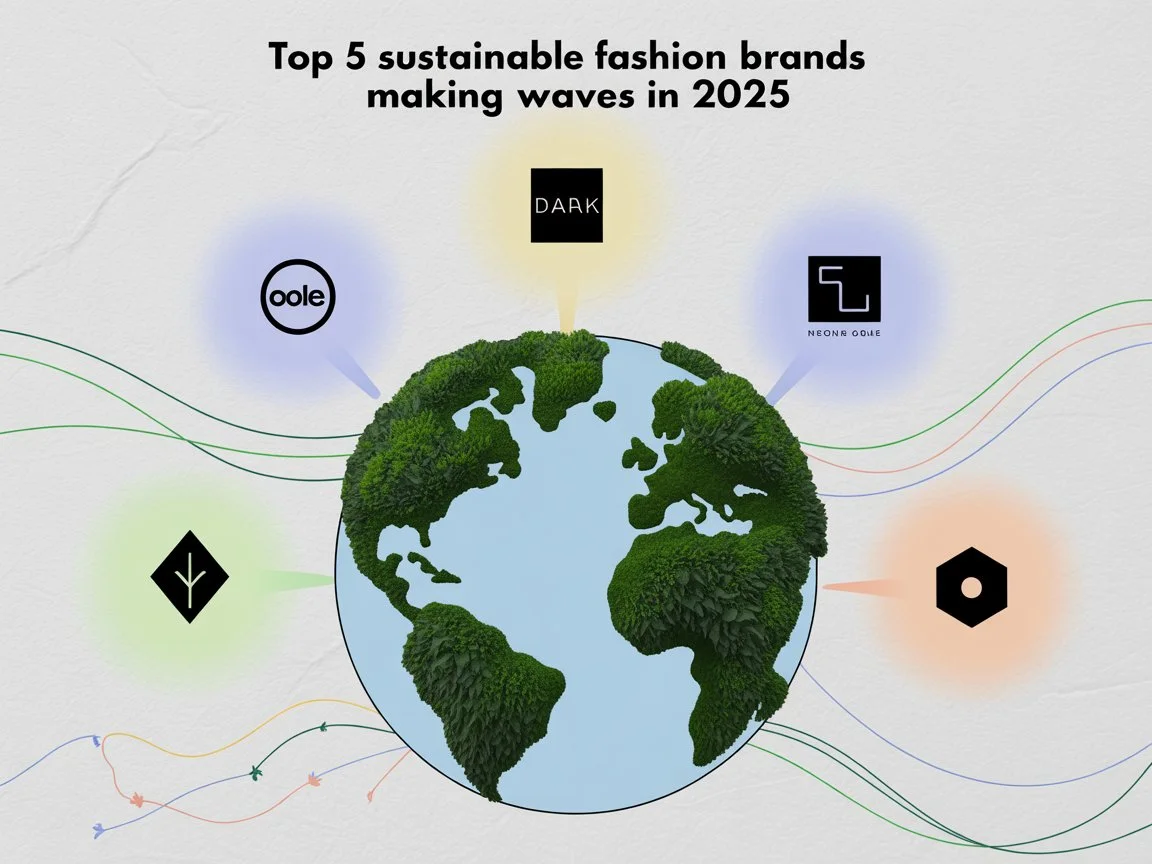The Rise of Sustainable Fashion in 2025
The fashion industry is undergoing a monumental shift. With an increasing global awareness of environmental issues, consumers are becoming more discerning about where and how their clothes are made. Sustainability is no longer a niche concern—it’s at the forefront of the fashion conversation, influencing everything from design to manufacturing processes. As we approach 2025, the intersection of technology, ethics, and style is redefining the way we shop, consume, and create fashion.
Overview of the Sustainability Movement in Fashion
The sustainability movement in fashion has gained tremendous traction in recent years. Consumers are demanding more eco-conscious choices, and brands are responding by embracing practices like ethical sourcing, recycling, upcycling, and the use of organic materials. Global issues like climate change, textile waste, and labor exploitation have pushed the fashion industry to rethink its impact on the environment. In 2025, this shift is not just a trend—it’s a paradigm that is reshaping how the fashion industry operates. Brands are striving to reduce their carbon footprint, adopt circular production models, and implement more transparent supply chains.
Why 2025 is a Pivotal Year for Sustainable Fashion
2025 is shaping up to be a turning point in the sustainable fashion movement. The rapid advancements in technology, such as 3D printing and artificial intelligence (AI), are revolutionizing the way clothing is designed and produced. Additionally, the growing role of blockchain technology is allowing brands to offer full transparency on sourcing and production practices. This digital shift is empowering consumers to make more informed choices while pushing brands to be accountable. On the consumer side, eco-consciousness is no longer a fringe behavior but a mainstream demand. Ethical fashion is becoming the norm, not the exception.
What This eBook Will Cover
This eBook dives into the five brands that are leading the charge in sustainable fashion in 2025. First up is EcoWear, a trailblazer in circular fashion, where every product is designed to be reused or recycled. Next, we explore GreenThreads, a brand revolutionizing the industry with a zero-waste production process. PureCotton is our third focus, showing how organic materials like cotton can lead to more sustainable garment creation. UrbanGreen follows, pioneering plant-based textiles and combining style with eco-friendly practices. Lastly, ReVibe brings us into the future with smart technology, such as 3D knitting and AI, that is shaping a more sustainable fashion landscape.
As you dive into these chapters, you’ll discover how each brand is innovating sustainability in different ways, providing consumers with choices that benefit both the planet and people. Through these stories, you’ll gain insights into how the fashion industry can evolve into a force for good—if we make conscious decisions about where our clothes come from.
Actionable Tips:
- Choose Brands with Circular Models: Opt for brands like EcoWear that prioritize recyclable materials and reusability.
- Demand Transparency: Ask brands about their sourcing and labor practices to ensure you’re supporting ethical fashion.
Mini-Summary:
The rise of sustainable fashion is a response to a growing consumer demand for eco-friendly practices in the fashion industry. 2025 marks a crucial year for sustainability, driven by technological advancements and a shift in consumer expectations. In this eBook, we will explore five innovative brands that are reshaping the future of fashion with their sustainable approaches.
Chapter 1: Brand #1 – EcoWear: Revolutionizing Circular Fashion
EcoWear is on a mission to revolutionize fashion by embracing a circular model, and in doing so, it’s reshaping the very way we think about clothing. As the fashion industry grapples with its environmental impact, EcoWear leads by example, demonstrating that style and sustainability can coexist. By focusing on products that are entirely recyclable or reusable, EcoWear is not just creating fashion—it’s creating a movement toward responsible consumption.
The Circular Fashion Model
At the core of EcoWear’s innovation is the concept of circular fashion. Unlike traditional models that contribute to the growing problem of textile waste, EcoWear designs products with their end-of-life in mind. Every garment is created to be easily disassembled, recycled, or reused, minimizing the environmental impact at each stage of the product lifecycle. This approach ensures that instead of adding to landfill waste, EcoWear’s pieces become part of a continuous loop—fashion that doesn’t fade away, but instead transforms into new items.
Actionable Tip: When shopping for clothing, prioritize brands that offer take-back programs or recycling initiatives. By supporting circular fashion, you contribute to reducing landfill waste.
Eco-Friendly Materials: A Game-Changer
EcoWear also stands out for its use of eco-friendly materials. From organic cotton to biodegradable fabrics, the brand sources textiles that leave a minimal environmental footprint. Organic cotton, for example, requires fewer pesticides and less water to grow compared to conventional cotton, making it a sustainable alternative. EcoWear also uses innovative materials such as Tencel, a fiber made from sustainably sourced wood pulp, known for its low environmental impact and biodegradability.
Actionable Tip: Look for clothing made from organic or biodegradable fabrics. These textiles ensure that you’re making a responsible choice when it comes to garment production and disposal.
Transparency and Ethical Sourcing
Transparency is a critical part of EcoWear’s mission. The brand is committed to providing customers with full visibility into the sourcing and production of its clothing. This transparency extends to every aspect of its supply chain, from fair wages for garment workers to ethical sourcing of raw materials. EcoWear partners only with suppliers who meet rigorous environmental and social standards, ensuring that their products are made with care for both people and the planet.
Actionable Tip: Research brands that prioritize transparency in their supply chain. Brands like EcoWear often provide detailed information about their production process, helping consumers make more informed, ethical choices.
Consumer Impact: How EcoWear is Changing Habits
EcoWear is committed to not only changing the way clothing is made but also how it’s consumed. Through educational campaigns and eco-conscious messaging, EcoWear encourages consumers to embrace mindful consumption. This includes choosing quality over quantity and repairing or repurposing garments instead of discarding them. In doing so, EcoWear is helping shift consumer behavior toward a more sustainable mindset, reducing fashion’s carbon footprint one piece at a time.
Actionable Tip: Practice mindful shopping by buying fewer, higher-quality items that you will wear for years. Look for brands that offer repair or customization services to extend the life of your garments.
Mini-Summary
EcoWear is leading the charge in circular fashion, proving that sustainability and style are not mutually exclusive. From their innovative recycling models to their use of eco-friendly materials and ethical sourcing, EcoWear is setting a new standard for the industry. By adopting these practices, consumers can make a significant impact on reducing waste and fostering a more sustainable fashion industry.
Chapter 2: Brand #2 – GreenThreads: Pioneering Zero-Waste Manufacturing
GreenThreads is a shining example of how fashion can evolve into something far more sustainable than we ever imagined. The company has taken the bold step of eliminating textile waste through an innovative, zero-waste production process. Their meticulous design-to-production methods ensure that every scrap of material is used, effectively diverting waste from landfills and making a meaningful impact on the environment. As consumers grow more conscious of the environmental consequences of fast fashion, GreenThreads is paving the way toward a more responsible, sustainable fashion industry.
Zero-Waste Production Process
GreenThreads’ commitment to zero-waste production is at the heart of their brand. Rather than using traditional methods that often lead to excess material waste, they employ a design-to-production process that ensures every piece of fabric is maximized. Through precise pattern making and innovative cutting techniques, GreenThreads uses even the smallest fabric scraps to create new items. This process minimizes waste in every stage of production and aligns with the principles of circular fashion.
Actionable Tip: Support brands like GreenThreads that employ zero-waste production methods. This can include purchasing from brands that use innovative fabric-cutting techniques or those that repurpose fabric scraps to create new products.
The Power of Upcycling and Recycling
GreenThreads takes the sustainability conversation a step further by embracing the power of upcycling and recycling. The brand sources recycled fibers from discarded textiles and upcycles old garments to create fresh, high-quality products. By reusing and revitalizing existing materials, GreenThreads contributes to reducing the demand for new resources, which in turn minimizes environmental harm. This approach not only gives a second life to fabrics but also prevents valuable materials from ending up in landfills.
Actionable Tip: Look for garments made from recycled fibers or upcycled materials. By supporting this practice, you help reduce the need for new textile production, thus lowering your carbon footprint.
Collaborations for Greater Impact
GreenThreads understands that true change happens when businesses work together. That’s why they’ve partnered with non-profits and other eco-brands to amplify the zero-waste movement. By joining forces with organizations that share their values, GreenThreads is able to scale their impact and educate a broader audience on the importance of sustainable fashion. These collaborations often lead to new solutions for eliminating waste and creating a more circular fashion industry.
Actionable Tip: Participate in sustainability-driven collaborations by supporting brands that partner with non-profits or other eco-conscious companies. These alliances help strengthen the movement and promote a broader shift toward sustainability.
Supporting Local Communities Through Sustainable Practices
Beyond reducing waste, GreenThreads is dedicated to supporting local artisans and communities. By working closely with small, ethical manufacturers, they help provide sustainable livelihoods and fair wages to artisans around the world. Their approach not only promotes sustainable practices but also strengthens the local economies in the communities they serve. This holistic view of sustainability helps bridge the gap between environmental and social responsibility.
Actionable Tip: Seek out brands that work with local artisans or provide fair-wage jobs. By doing so, you are not only supporting eco-friendly practices but also contributing to ethical, community-focused production.
Mini-Summary
GreenThreads is a leading example of zero-waste fashion. By employing innovative, waste-reducing production techniques and embracing upcycling and recycling, the brand has set a new standard for sustainable fashion. Additionally, their collaborations with other like-minded organizations and commitment to supporting local communities help amplify the broader sustainability movement. Supporting GreenThreads means supporting a future where fashion contributes positively to both the planet and society.
Chapter 3: Brand #3 – PureCotton: Leading the Way with Organic Fabrics
PureCotton is transforming the fashion industry with its dedication to organic cotton. As the world becomes more aware of the environmental impact of conventional cotton farming, PureCotton is proving that sustainable fabrics can be luxurious without compromising on quality. Their commitment to organic cotton is not just about offering a different fabric; it’s about taking responsibility for the entire process, from the soil to the final garment.
The Benefits of Organic Cotton in Fashion
Organic cotton is at the core of PureCotton’s offerings. Unlike conventional cotton, organic cotton is grown without the use of harmful pesticides and fertilizers, significantly reducing the negative environmental impact. Organic farming practices also use less water compared to traditional cotton farming, helping to conserve one of the world’s most precious resources. By focusing on organic cotton, PureCotton is offering a premium product that is not only healthier for the environment but also for the consumer.
Actionable Tip: Choose clothing made from organic cotton to support environmentally friendly agricultural practices. This reduces your exposure to chemicals and supports sustainable farming methods.
Innovations in Cotton Farming and Textile Processing
PureCotton goes beyond simply using organic cotton—they are innovators in sustainable farming and textile processing. The brand works with farmers who implement water-efficient techniques, ensuring that every drop of water is used wisely. Their commitment to sustainable cotton farming includes crop rotation, soil health management, and eco-friendly pest control methods, all of which help preserve the land and promote biodiversity.
Actionable Tip: Opt for brands that emphasize sustainable farming techniques. Brands like PureCotton often work with certified farms that maintain high environmental standards.
Commitment to Fair Trade and Ethical Labor
PureCotton is equally focused on the social sustainability of its production process. They ensure that the workers involved in the cotton farming and garment manufacturing process receive fair wages and work in safe, ethical conditions. By partnering with Fair Trade-certified farms and factories, PureCotton guarantees that their supply chain meets rigorous labor standards, creating a more just and equitable fashion ecosystem.
Actionable Tip: Look for brands that are Fair Trade-certified or partner with ethical factories. This helps ensure that your purchases are supporting not only sustainable practices but also fair labor conditions.
Expanding the Market for Organic Cotton
PureCotton is working to expand the market for organic cotton by making it more accessible to the mainstream. The brand’s success is encouraging other companies to consider organic cotton in their product lines, which could eventually lead to a broader shift in the industry toward sustainable materials. By scaling production and demand for organic cotton, PureCotton is helping create a more sustainable fashion industry on a global scale.
Actionable Tip: Support brands that are helping grow the market for organic materials. Your purchase contributes to a larger movement that can shift the entire industry toward sustainable practices.
Mini-Summary
PureCotton is leading the way in sustainable fashion by promoting organic cotton, which offers both environmental and health benefits. Their focus on water-efficient farming, ethical labor practices, and scaling the use of organic materials is setting a powerful example for the industry. Supporting PureCotton is an investment in a future where fashion is healthier for both people and the planet.
Chapter 4: Brand #4 – UrbanGreen: Fashion Forward with Plant-Based Textiles
UrbanGreen is leading the charge in using plant-based textiles to revolutionize the fashion industry. Known for their use of sustainable fabrics such as hemp, bamboo, and Tencel, UrbanGreen combines environmental responsibility with high-fashion aesthetics. Their commitment to plant-based textiles reflects their core belief that eco-friendly materials can be stylish, functional, and gentle on the planet. UrbanGreen’s innovative use of these fabrics demonstrates that sustainable fashion can be as luxurious as it is conscientious.
Exploring Plant-Based Fabrics: The UrbanGreen Approach
UrbanGreen uses plant-based textiles like hemp, bamboo, and Tencel to create its collection of sustainable clothing. These materials require significantly less water and fewer pesticides to grow compared to traditional cotton, making them a more sustainable option. Hemp, for example, uses minimal water, thrives without pesticides, and is incredibly durable. Bamboo, a fast-growing resource, can be harvested without harming the environment, and Tencel, made from wood pulp, is biodegradable and produced in a closed-loop process that minimizes waste.
Actionable Tip: Support brands that use sustainable fabrics like hemp and bamboo. These materials are not only better for the environment, but they also offer durable, long-lasting alternatives to conventional textiles.
Creating Fashionable, Functional, and Eco-Friendly Clothing
UrbanGreen doesn’t just focus on sustainability—it ensures that eco-friendly fashion can also be chic and practical. By carefully designing garments that marry style with sustainability, UrbanGreen shows that eco-conscious clothing doesn’t have to compromise on style or function. Their pieces range from casual wear to sophisticated, high-fashion designs, proving that you don’t have to sacrifice aesthetics to make an environmentally friendly choice. Each garment is designed with versatility and longevity in mind, making it a long-term investment for those who care about both style and the planet.
Actionable Tip: Choose timeless, versatile pieces that blend fashion with sustainability. Opt for brands like UrbanGreen that create eco-friendly clothes designed to last for years.
Innovative Textile Production: Reducing Carbon Footprint
UrbanGreen goes beyond the fabric itself by investing in cutting-edge production methods to reduce its carbon footprint. The company focuses on energy-efficient dyeing techniques that use less water and fewer harmful chemicals, and they’ve invested in sustainable energy sources for their production processes. These efforts contribute to a significant reduction in the overall environmental impact of their textiles. UrbanGreen’s dedication to minimizing energy use and water waste throughout the production process helps to create garments that are not only stylish but also responsible.
Actionable Tip: Look for brands that use energy-efficient production methods and water-saving techniques. Supporting these brands helps reduce the fashion industry’s environmental footprint.
Supporting Biodiversity and Regenerative Farming
UrbanGreen’s commitment extends beyond textiles—they invest in regenerative farming practices that help restore ecosystems and protect biodiversity. By partnering with farmers who focus on soil health, crop rotation, and other sustainable farming practices, UrbanGreen is helping to preserve the integrity of the land and promote biodiversity. These farming practices reduce the depletion of natural resources and contribute to the long-term health of ecosystems, ensuring that the materials used in their clothing are produced in a way that supports the environment.
Actionable Tip: Support brands that work with regenerative farmers and promote sustainable agricultural practices. By doing so, you contribute to ecosystem restoration and biodiversity preservation.
Mini-Summary
UrbanGreen is at the forefront of using plant-based textiles to revolutionize fashion. Through their use of sustainable materials like hemp, bamboo, and Tencel, they provide eco-friendly options without compromising style. Their commitment to reducing carbon footprints through energy-efficient production methods and supporting regenerative farming further solidifies their role as leaders in sustainable fashion. By supporting UrbanGreen, consumers contribute to a more sustainable, ethical fashion industry while still enjoying high-quality, fashionable clothing.
Chapter 5: Brand #5 – ReVibe: Shaping the Future with Smart Technology
ReVibe is at the cutting edge of sustainable fashion, integrating advanced technology to reduce waste and create garments with built-in sustainability. By leveraging technologies like 3D knitting, AI, and digital textiles, ReVibe is not just pushing boundaries—it’s reshaping the entire fashion production process. Their commitment to using smart technology to create zero-waste garments makes them a prime example of how innovation can drive sustainability in the fashion industry.

The Role of Technology in Sustainable Fashion
ReVibe has embraced innovative technologies, such as 3D knitting and AI, to create garments that are produced with minimal waste. 3D knitting, in particular, allows garments to be made in a single, seamless process, significantly reducing material waste that typically results from traditional garment production. AI is also used to optimize designs, ensuring that each garment is produced in the most efficient way possible. This technological integration not only makes production more efficient but also enables ReVibe to create unique, tailored designs with minimal environmental impact.
Actionable Tip: Choose brands that use innovative technologies like 3D knitting to reduce waste. These technologies ensure that the production process is both resource-efficient and environmentally responsible.
Smart Fabrics and Clothing with Built-In Sustainability
ReVibe’s commitment to sustainability goes beyond production methods. They incorporate smart fabrics into their clothing, which are not only functional but can also be recycled, repurposed, or biodegraded. These fabrics are designed to minimize environmental impact and provide consumers with clothing that is built to last. ReVibe’s smart fabrics help close the loop on textile waste, making their garments part of a circular economy where old items are regenerated into new ones.
Actionable Tip: Look for brands that use smart fabrics designed for recycling or biodegradation. By supporting these brands, you’re contributing to the reduction of textile waste.
Creating a Sustainable Fashion Supply Chain with Blockchain
Transparency is key in sustainable fashion, and ReVibe uses blockchain technology to track every step of its supply chain. This innovative use of blockchain ensures that consumers have access to accurate information about the origins of their garments, from raw materials to finished product. By offering full traceability, ReVibe is helping to build trust with consumers and ensure that the products they purchase are ethically produced and sustainably sourced.
Actionable Tip: Choose brands that offer transparency through technologies like blockchain. This ensures that you’re supporting ethically produced and sustainable fashion.
Innovating for the Future: Sustainable Fashion’s Tech-Driven Evolution
ReVibe is not just about today—it’s about shaping the future of fashion. They are pioneering new technologies and researching sustainable materials that will redefine the industry. From experimenting with biodegradable textiles to investing in cutting-edge manufacturing techniques, ReVibe is at the forefront of fashion’s tech-driven evolution. Their commitment to innovation ensures that sustainable fashion will continue to evolve in a way that is both exciting and environmentally responsible.
Actionable Tip: Stay informed about new technologies in fashion, such as biodegradable textiles and AI-driven design, that promise to make the industry more sustainable.
Mini-Summary
ReVibe is using smart technology to reshape the future of sustainable fashion. From 3D knitting to blockchain transparency, ReVibe is leading the way in reducing waste, optimizing production, and creating garments that are both sustainable and stylish. Their commitment to innovation and circular fashion ensures that ReVibe will continue to shape the future of fashion, one technologically advanced, eco-friendly garment at a time.
Chapter 6: Comparing the Leaders: What Sets These Brands Apart?
As the world of sustainable fashion continues to evolve, several brands are standing out for their unique approaches to environmental responsibility. These five leaders—EcoWear, GreenThreads, PureCotton, UrbanGreen, and ReVibe—each bring something distinct to the table, making sustainability more than just a buzzword in the fashion industry. Their innovative practices, from circular fashion to zero-waste manufacturing, are setting new standards for the future of fashion.

Unique Approaches to Sustainability
Each of these brands has adopted different strategies to promote sustainability in fashion. EcoWear champions circular fashion, focusing on designing products that can be reused, recycled, or repurposed at the end of their life cycle. GreenThreads, on the other hand, has taken the zero-waste approach by creating garments using every scrap of material, ensuring that no textile is left to waste. PureCotton emphasizes organic cotton, helping reduce pesticide use and water consumption, while UrbanGreen is revolutionizing fashion with plant-based textiles like hemp, bamboo, and Tencel, which require fewer resources to grow. ReVibe pushes the envelope by incorporating smart technology, from AI to blockchain, creating zero-waste garments and providing transparency in the supply chain.
Actionable Tip: Look for brands with clear sustainability models, whether that’s circular fashion, zero-waste production, or the use of plant-based materials. Each approach contributes to reducing the environmental impact of fashion.
Innovations in Materials and Technology
The material choices and technological advancements made by these brands are transforming the sustainability landscape. EcoWear uses biodegradable fabrics, while GreenThreads sources upcycled fibers, giving old garments new life. PureCotton’s commitment to organic cotton has expanded the availability of sustainable fabrics, promoting eco-friendly farming practices. UrbanGreen’s plant-based textiles, such as hemp and Tencel, offer durable alternatives to synthetic fibers, while ReVibe integrates cutting-edge technology like 3D knitting and AI to optimize garment production and reduce waste.
Actionable Tip: When shopping, opt for brands that use innovative, eco-friendly materials such as organic cotton, recycled fibers, or plant-based textiles. These materials significantly lower the environmental impact of garment production.
Impact on the Global Fashion Industry
These brands aren’t just making waves—they’re reshaping the entire fashion industry. Through their sustainable practices, they’re setting new benchmarks for the industry at large. EcoWear’s circular fashion model is pushing for a broader shift toward reusability and recyclability, while GreenThreads’ zero-waste production is setting a new standard for waste reduction. UrbanGreen’s plant-based textiles are challenging traditional fabric choices, and ReVibe’s tech-driven approach is making waves in both sustainability and transparency. Together, they are paving the way for more sustainable practices to become the norm in fashion, not the exception.
Actionable Tip: Support brands that are setting sustainability trends. By backing companies that lead in eco-innovation, you help shift the entire industry toward more responsible practices.
Consumer Education and Awareness
Each of these brands understands the power of consumer education. EcoWear educates customers about the importance of recycling and conscious consumption, while GreenThreads advocates for waste-free fashion. PureCotton raises awareness about the benefits of organic cotton farming, and UrbanGreen promotes the use of plant-based textiles as an alternative to conventional fabrics. ReVibe, with its emphasis on smart technology, informs consumers about the future of sustainable fashion and the role they can play in driving change.
Actionable Tip: Stay informed about the environmental impact of your clothing choices and support brands that educate consumers on sustainable practices. This helps you make conscious choices and encourages others to do the same.
Mini-Summary
These five brands—EcoWear, GreenThreads, PureCotton, UrbanGreen, and ReVibe—are each taking bold steps toward sustainability in fashion. Their unique approaches, from circular fashion to zero-waste production and innovative fabric use, are shaping the future of the fashion industry. By supporting these brands and educating yourself on sustainable fashion, you can help drive positive change for both the industry and the planet.
Chapter 7: The Future of Sustainable Fashion: What’s Next?
The sustainable fashion movement has come a long way, but we’re just beginning to scratch the surface. As consumers demand more eco-friendly options, the fashion industry is responding with a host of innovative trends and technologies. However, the path to a fully sustainable fashion industry is still filled with challenges, and scaling sustainability across the industry remains a key hurdle.
Emerging Trends in Eco-Friendly Fashion
Several exciting trends are reshaping the landscape of sustainable fashion. 3D printing is gaining traction, allowing for highly customized garments with minimal waste. Eco-friendly tech, such as energy-efficient dyeing methods and plant-based fabrics, is also gaining ground, significantly reducing the environmental impact of production. Green logistics, such as more efficient transportation methods, is becoming a key focus for reducing the carbon footprint of the fashion supply chain.
Actionable Tip: Look for brands that incorporate emerging technologies like 3D printing and energy-efficient dyeing methods. These innovations reduce material waste and energy consumption, further reducing the carbon footprint of your wardrobe.
Challenges in Scaling Sustainability Across the Industry
One of the biggest challenges in scaling sustainability across the fashion industry is the cost and complexity of transitioning to more eco-friendly practices. For smaller brands, investing in sustainable materials and technology can be a significant financial burden. Additionally, many brands still rely on fast fashion models that prioritize speed and cost over sustainability, making widespread adoption difficult. However, as consumer demand for sustainability grows, more brands will be forced to adapt to these new standards.
Actionable Tip: Support sustainable fashion brands, even if they’re not the biggest names in the industry. Your purchasing decisions help accelerate the adoption of eco-friendly practices.

The Role of Consumers in Shaping Fashion’s Future
Consumers are the driving force behind the push for sustainable fashion. As demand for ethical and eco-friendly clothing increases, more brands are prioritizing sustainability. By choosing to support sustainable brands, consumers can influence the market and encourage even larger companies to adopt better practices. This shift is not just about buying new clothes—it’s about making mindful choices that help protect the planet for future generations.
Actionable Tip: Vote with your wallet by supporting brands that prioritize sustainability. Your choices can help push the industry toward a more sustainable future.
Innovations to Watch for in 2025 and Beyond
As we look to the future, there are several exciting innovations on the horizon for the fashion industry. New biodegradable fabrics, more efficient production methods, and advances in sustainable manufacturing will all play a role in making fashion more eco-friendly. Additionally, AI and machine learning are being explored for their potential to optimize the fashion supply chain, reducing waste and improving efficiency. These innovations will continue to reshape the industry, bringing us closer to a fully sustainable fashion future.
Actionable Tip: Stay ahead of the curve by supporting brands that are embracing these innovations. By doing so, you’re helping to accelerate the transition to a more sustainable fashion industry.
Mini-Summary
The future of sustainable fashion is bright, with emerging technologies and trends that promise to reduce the industry’s environmental footprint. While challenges remain in scaling sustainability, consumer demand for eco-friendly options is pushing the industry in the right direction. By supporting innovative brands and staying informed about the latest advancements, you can help shape the future of fashion for the better.
Conclusion: How to Support Sustainable Fashion
Sustainable fashion is no longer a niche—it’s the future of the industry. As consumers, we hold the power to shape that future by supporting brands that prioritize sustainability and making conscious choices about the clothes we buy. With each purchase, we send a message that we care about the planet and the people who make our clothes.
Supporting the Right Brands
The first step in supporting sustainable fashion is choosing to buy from brands that prioritize eco-friendly materials, ethical labor practices, and transparency in their supply chain. By supporting these brands, you are investing in a more sustainable future for fashion.
Actionable Tip: Seek out brands with clear sustainability goals and practices. These brands are dedicated to making a positive impact on the planet and society.
Practical Steps for Creating a Sustainable Wardrobe
In addition to supporting the right brands, consumers can make a significant impact by making smarter choices about their wardrobes. Opt for high-quality, timeless pieces that will last longer, buy second-hand or vintage items, and repair or repurpose old clothing instead of discarding it. These practices help extend the life cycle of your clothes and reduce waste.
Actionable Tip: Invest in high-quality, long-lasting garments and make a habit of buying second-hand. This reduces demand for fast fashion and helps keep clothes out of landfills.
The Power of Collective Action
Collective action is key to creating a more sustainable fashion industry. By sharing information, advocating for change, and encouraging others to make more eco-conscious choices, we can all contribute to a movement that will create lasting change in the fashion industry. Together, we can make sustainability the norm in fashion.
Actionable Tip: Spread the word about sustainable fashion to your friends and family. The more people who are aware of the issues and solutions, the faster the industry will change.
Mini-Summary
Supporting sustainable fashion is about making informed, conscious choices. By choosing the right brands, investing in high-quality clothing, and advocating for change, consumers can help shape a future where fashion is both stylish and sustainable. Together, we have the power to make a positive impact on the industry and the planet.









Leave a Reply